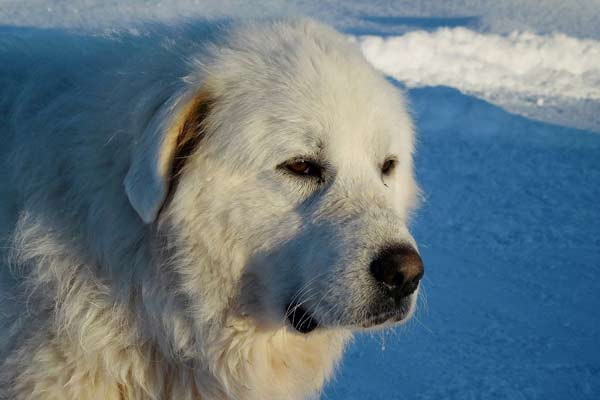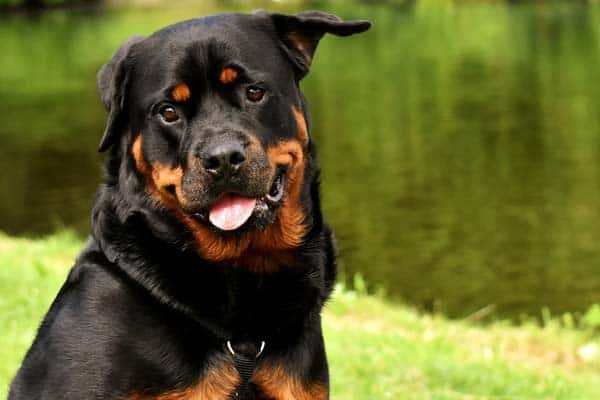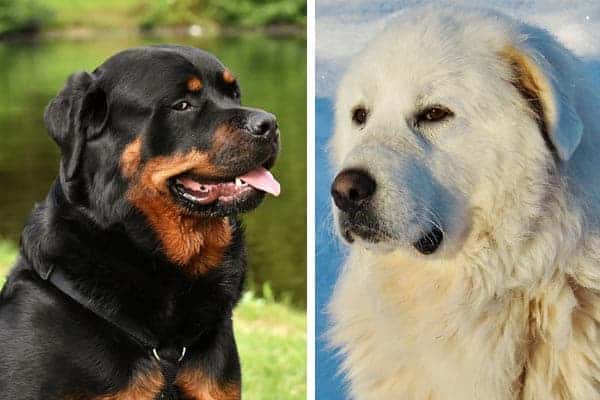The Great Pyrenees and the Rottweilers are two respected, well-known, and much-loved purebred dog breeds in the world of companion canines.
The Great Pyrenees Rottweiler mix is a newer hybrid dog breed that may one day develop into a new purebred dog breed in its own right.
For now, however, breeders are in the early stages of selective breeding between these two different purebred genetic lines. This makes breeding both exciting and somewhat unpredictable, as we will talk about more here.
There are some advantages and disadvantages to be aware of whenever you consider bringing a large to giant breed dog into your life, especially if that big dog is also a hybrid.
Read on to learn all about the Great Pyrenees Rottweiler mix to decide if this might be your next companion canine!
Great Pyrenees Rottweiler Mix
The Great Pyrenees Rottweiler mix is sometimes called the Great Weilernees or just the Greatweiler.
Both are great names for this new up-and-coming hybrid dog breed.
Early generation Greatweiler puppies have one purebred Great Pyrenees parent dog and one Rottweiler parent dog. Later-generation puppies have two hybrid Greatweiler parent dogs.
Watch an Adorable Great Pyrenees Rottweiler Mix Puppy
This absolutely adorable owner video shows you just why people are falling in love with the Great Pyrenees Rottweiler mix dog.
Could there be anything cuter than a giant puppy sitting on the floor while chasing its own tail with absolute focus and determination?
The History of the Great Pyrenees and the Rottweiler
One of the most reliable ways of gathering information about any hybrid dog breed is to study the history of each purebred parent dog – in this case, we will study the Great Pyrenees and the Rottweiler dog breed histories.
Great Pyrenees history
The Great Pyrenees is the 66th most popular (out of 195 American Kennel Club registered dog breeds) purebred dog breed in America today.
The Great Pyrenees is a centuries-old purebred dog breed that was bred to specialize in herding and livestock guarding.
This dog takes its breed name from the Pyrenees Mountains, a mountain range that sits along the border between the countries of France and Spain.
Up high in the mountains, livestock predators frequently included big cats and grizzly bears as well as human thieves. And the weather was frequently difficult and harsh.
The Great Pyrenees was bred to have an extreme tolerance for weather conditions and extreme patience to work long hours heading off predators and herding the livestock.
Once livestock guarding and herding was no longer so necessary, the Great Pyrenees breed found new life as the official “Royal Dog of France” under King Louis XIV, where their giant size made them useful for guarding the royal residences.
Rottweiler history
The Rottweiler is the 8th most popular (out of 195 American Kennel Club registered dog breeds) purebred dog breed in America today.
Rottweilers as a dog breed may be even more ancient than the Great Pyrenees. Many accounts date the breed back as far as the era of the Roman legions!
Like Great Pyrenees, Rottweilers principally served as livestock guarding and herding dogs, facing down big predator animal and human threats with bravery and strength.
Later, the breed migrated to Germany and patrolled large herds of cattle to and from a town called Rottweil, from which their modern breed name is derived.
Today, Rottweilers are prized as military, police, and personal protection dogs, guide dogs for the blind, service dogs, search and rescue dogs, and pet dogs.

Great Pyrenees Rottweiler Mix: Personality and Temperament
Another important criteria to consider when choosing a hybrid pet dog breed is what mix of personality and temperament traits your pup might inherit from either parent dog.
So let’s take a closer look at the typical personality and temperament for the Great Pyrenees and the Rottweiler dog breeds.
Great Pyrenees personality and temperament
The Great Pyrenees might be enormous and intimidating size-wise, but these dogs are typically incredibly calm unless they need to be otherwise.
As Vetstreet points out, the Great Pyrenees, or “Pyr” as many owners nickname this breed, are famously good with kids. These dogs can also be good with other pets such as other pet dogs or cats.
However, because the Pyr is so enormous size-wise, it may not be ideal to bring this dog into a home with very young children who might be injured if this dog were to accidentally lean or sit on them.
Rottweiler personality and temperament
The Rottweiler has garnered a reputation as an aggressive and potentially dangerous dog breed. However, well-bred, well-socialized, and well-trained Rottweilers are typically loving and silly with their people and aloof with others.
Rotties, as owners have nicknamed them, are incredibly popular dogs and are great guard dogs for family members of all ages. However, because of their size and strength, here again, Rottweilers are not recommended for families with young children.
As well, Rottweilers can be less tolerant of children who are too young to know how to play gently with dogs. As well, as VetStreet explains, because of their strong prey drive, the Rottweiler is not recommended as a good choice for families with other pets.
Great Pyrenees Rottweiler personality and temperament
From this overview, you can feel reasonably sure that your Great Pyrenees Rottweiler mix dog will be strong, smart, and ready to stand guard for you and your family. But if your family includes other vulnerable pet animals, especially smaller prey species, or if you have very young children that are still small, you may want to defer bringing one of these enormous and heavy dogs home to stay.
Great Pyrenees Rottweiler Mix: Size, Height, and Weight
Speaking of size, let’s take a closer look at the Great Pyrenees Rottweiler mix when it comes to size, height, and weight.
As you will see, both of these dogs are very large in adulthood, which can be a factor in deciding whether you can accommodate a Greatweiler in your life.
Great Pyrenees size, height, and weight
On average, the Great Pyrenees can weigh anywhere from 85 to 100+ pounds, with females being on average about 15 pounds lighter than males.
The Great Pyrenees will typically stand anywhere from 25 to 32 inches tall. Here again, adult females will generally be two to three inches shorter (paw pads to shoulder tops) in adulthood than adult males.
Rottweiler size, height, and weight
Rottweilers can be even bigger than Great Pyrenees, weighing in at 80 to 135+ pounds when fully grown. Adult females are typically about 15 pounds lighter than adult males.
Height-wise, Rotties typically stand 22 to 27 inches tall, with females being on average two inches shorter than males.
Great Pyrenees Rottweiler size, height, and weight
This gives you a clear picture of the sizable dog your Greatweiler puppy will grow up to be. It is important to remember that bigger dogs need bigger everything, from bedding and crates to bags of food and toys.
However, it is not always the case that a bigger dog breed will need more space, which is what we will talk about in the next section here.
Great Pyrenees Rottweiler Mix: Training and Exercise Needs
The Great Pyrenees Rottweiler mix is an interesting crossbreeding when it comes to energy levels and exercise needs.
There are also some special training and exercise considerations you will need to be aware of when you are bringing up a large or giant breed puppy.
Great Pyrenees training and exercise needs
For the most part, the Great Pyrenees is considered a moderate to low energy dog breed.
This might surprise you, given the Great Pyrenees’ strong working dog background. But these dogs didn’t have to exert a tremendous amount of energy continuously. It was more important that they be big, strong, and very patient.
In a pet dog setting, the Great Pyrenees will be happy with daily walks and some interactive playtime daily.
As long as you can meet these needs out of the home, you don’t need a big yard (although you do need a secure yard because these dogs have a strong ability to escape and go wandering as per their long histories as independent herding dogs).
The Great Pyrenees is always going to be somewhat challenging to train, simply because these dogs have been bred to think on their own and work at long distances from their human herding partners.
The Great Pyrenees does best with short, high-engagement training exercises using positive reinforcement, including treats, pats, praise, and playtime.
Rottweiler training and exercise needs
The Rottweiler is a more active and energetic dog breed than the Great Pyrenees, but here again, these dogs do best with bursts of activity daily rather than continuous all-go, no-stop activity.
This is especially the case once your Rottie outgrows puppyhood.
Rottweilers definitely need early and ongoing training and socialization to temper their strong guarding and protective instincts and their prey drive.
A Rottweiler needs to learn from their people how to tell the difference between a neutral situation and a real threat. Most problems with aggression in Rottweilers come from inadequate or incomplete training that leaves too much to chance.
As the Great Pyrenees, the Rottweiler can be stubborn. This is because these smart dogs also have a background of working independently at great distances from their people, making their own decisions as situations changed.
This means that here again, you will need to make sure that your yard (if you have one) is completely secure and escape-proof from digging, jumping, climbing, knocking outboards, and opening the gate, as Rotties have a strong drive to wander.
So Rottweilers, like Great Pyrenees dogs, need short, focused, extremely positive training sessions that are liberally sprinkled with praise, treats, playtime, and pats for rewards.
Rottweilers are very people-centric dogs and this will work in your favor during training.
Great Pyrenees Rottweiler training and exercise needs
As you can see, with a Great Pyrenees Rottweiler mix dog, you are going to be bringing home a very smart, independent dog that may be somewhat stubborn about obedience training and learning basic commands.
Your key to training success is going to be keeping training sessions positive, short, very engaging, and interesting to your dog.
One additional special consideration for both the Great Pyrenees and the Rottweiler dog breeds when it comes to early exercise and training is taking care not to cause joint or skeletal damaged by too much activity too soon.
You will need to work with your canine veterinarian to determine when your Greatweiler is finally finished growing and the growth plates of bone in the legs have closed and hardened.
If you do too much vigorous activity with your dog before this occurs, it is very possible to cause permanent structural deformity and permanent lameness.

Great Pyrenees Rottweiler Mix: Shedding, Grooming, and Coat Care
So now let’s move along to another big topic of interest for prospective dog owners – how much will your Great Pyrenees Rottweiler mix shed?
Will you have to do a lot of brushing and grooming and coat care? Let’s find out now.
Great Pyrenees shedding, grooming, and coat care
The Great Pyrenees often appear even bigger and taller than these dogs actually are just because of their thick, full, long hair coat.
The good news is that this coat actually doesn’t tangle or mat very often, despite that it is long and very thick and double layer.
The not-so-good news is that these dogs shed continuously all year long and will do something called “blowing coat” seasonally as the underlayer sheds out.
Rottweiler shedding, grooming, and coat care
Rottweilers have a short, neat coat that is a double layer, as most working dog breeds dog.
They require only minimal brushing and grooming but will shed seasonally and year-round.
Great Pyrenees Rottweiler shedding, grooming, and coat care
From this, you can see that your Greatweiler dog will shed. However, you won’t have a lot of brushing and grooming chores to tend to.
Great Pyrenees Rottweiler Mix: Longevity and Health
Making a lifetime commitment to any companion canine is a big decision! You definitely want to make sure that you select the healthiest puppy or rescue dog.
While large and giant breed dogs like the Great Pyrenees and the Rottweiler, in general, have lower typical life expectancies than their smaller breed peers, doing careful research can still ensure your precious pup is with you for as long as possible.
Learning about the known heritable (genetic) health issues that are associated with each purebred dog parent – in this case, the Great Pyrenees and the Rottweiler dog breeds – can help you ask the right questions of any hybrid dog breeder.
Reputable breeders are always willing to share pre-screening pre-breeding test results and often will volunteer this information without even being asked.
A responsible breeder that values its reputation in the community will also provide you with proof of required vaccinations and immunizations and an initial guarantee of health. Do not buy a puppy from any breeder that will not offer you these guarantees.
Great Pyrenees longevity and health
According to the Canine Health Information Center (CHIC) database, the Great Pyrenees has the following known genetic (heritable) health issues that parent dogs could potentially pass along to puppies:
- Hip dysplasia.
- Patellar luxation.
- Elbow dysplasia.
- Eye issues.
- Thyroid issues.
- Cardiac issues.
- Shoulder osteochondritis dissecans (OCD).
- Glanzmann’s Thrombasthenia (GT).
The average estimated life expectancy for a healthy adult Great Pyrenees dog is 10 to 12 years.
Rottweiler longevity and health
According to the Canine Health Information Center (CHIC) database, the Rottweiler dog has the following known genetic (heritable) health issues that parent dogs could potentially pass along to puppies:
- Elbow dysplasia.
- Hip dysplasia.
- Cardiac issues.
- Eye issues.
- Juvenile Laryngeal Paralysis & Polyneuropathy (JLPP).
The overall life expectancy for a healthy adult Rottweiler dog is nine to 10 years.
Great Pyrenees Rottweiler longevity and health
Overall, you can see that there are several overlapping genetic health concerns to be aware of when choosing your Great Pyrenees Rottweiler puppy, including heart, eye, joint, blood, and thyroid issues.
When you choose the healthiest possible Greatweiler puppy, you can expect your dog to be with you for nine to 12 years, which is average for a large to giant breed dog.
Great Pyrenees Rottweiler Mix: Is This the Right Dog for You?
Is the Great Pyrenees Rottweiler mix dog the right next companion canine for you?
For the right person with sufficient time to devote and space to play and run, the Greatweiler can be a fantastic pet dog to choose from.
Related Post
